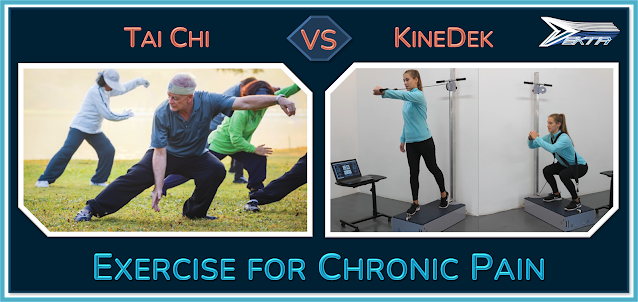Unlocking Pain Relief:
KineDek's Novel Approach to Chronic Pain Management
 Picture: Evergreen
Picture: EvergreenNavigating the Complex Relationship Between Exercise and
Chronic Pain
Chronic pain can become a consistent and unwelcome part of
many individuals' lives, turning routine activities into daunting tasks.
Traditionally, one might think that exercising is counterintuitive when in
pain, but newer research offers a refreshing perspective. An article from The
New York Times, aptly titled "How to exercise with Chronic Pain," has
pointed out that exercise might indeed be a pathway to relief for those
grappling with chronic pain conditions.
Recent studies have demonstrated that certain movements, like tai chi, can be therapeutic for many who experience chronic pain. While tai chi has been championed as an effective method to alleviate pain for conditions such as fibromyalgia and osteoarthritis, it's worth noting that not every movement within tai chi is beneficial for all.
Researchers at the University of Texas Health Science Center at San Antonio, using advanced motion capture sensors, have highlighted that some tai chi movements, including weight shifting and squatting, can potentially aggravate pain for some individuals. Such findings emphasize the importance of personalized exercise regimens, particularly for those with chronic pain.
Tai chi, despite its benefits, is intricate and demands proper instruction. Its suggested regimen of 20 to 30 minutes, practiced twice daily, may not be feasible for everyone.
The KineDek: Immediate Relief for Chronic Pain
For those exploring alternative solutions to chronic pain management, the KineDek AI-CRT (AI-enabled Compensating Resistance Technology) presents a revolutionary option. Standing out from traditional exercise forms that often require more than 6 week adaptation periods, the KineDek provides instant pain relief for most individuals across a wide spectrum of chronic pain conditions.
The cornerstone of the KineDek's success is its unparalleled
efficiency. It utilizes a patented AI-enabled compensating contraction method (AI-CRT),
ensuring no aggravation of pain or inflammation. By strategically targeting
muscle groups around affected areas, the KineDek triggers a powerful
anti-inflammatory response, providing relief that can persist for up to five
days. This not only mitigates pain but also promotes a conducive environment
for healing, unless further injury is introduced.
But the KineDek's impact doesn't stop at physical relief. Users often report enhanced mental well-being, citing reductions in anxiety, improved mood, and a surge in overall energy.
Emerging scientific research underscores the role of muscle contractions in driving essential metabolic activities. From pain alleviation, inflammation control, organ and tissue regeneration, bolstering bone health, to mood upliftment—these benefits are only unlocked when muscles are actively engaged. It's crucial to highlight that these benefits are most pronounced when inflammation isn't concurrently triggered as a result of muscle trauma, a common repercussion of traditional exercise methods. This becomes even more pertinent for elderly individuals facing muscle atrophy or anyone grappling with chronic pain conditions.
As the medical landscape shifts toward harnessing this innate potential through pharmaceutical avenues—especially with the rise of biologics like mRNA vaccines that replicate our body's defense mechanisms but may bear potential side-effects—the KineDek stands out. It seamlessly connects with our body's inherent capacity for self-healing.
This profound understanding underscores the fundamental concept that Exercise is Medicine.
The best part? These myriad benefits are packed into a concise 20-minute weekly session, making it an ideal choice for those with demanding lifestyles.
In conclusion, journeying through chronic pain needn't be a tumultuous ordeal. While modalities like tai chi provide respite to a select few, the KineDek stands tall as a swift, potent panacea for diverse chronic pain ailments. Step into a world where pain is not a daily battle, but a conquerable challenge, with the KineDek.
Scientific Note
Side Note: Qigong
Tai Chi is a branch of the ancient Chinese discipline of Qigong, believed to amplify the body's Chi, or vital life energy. After undergoing three sessions on the KineDek, a seasoned Qigong practitioner shared her enlightening experience. According to her insights, traditional exercises failed to evoke the life force sensation, a stark contrast to her Qigong experiences. The KineDek, however, intensified this feeling, likened to ebullient energy currents within. Of particular note, her regular Qigong practices did little to alleviate the chronic pain in her knee and hip, a lingering result of a fall five years prior that had progressively worsened. Yet, KineDek sessions rendered her pain-free until its resurfacing on the fifth day.







